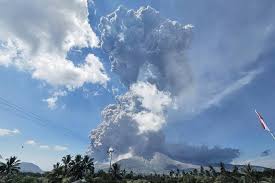Mount Lewotobi Erupts Again, Ash Blankets Villages in Indonesia
Residents in several Indonesian villages wore masks and stayed indoors Tuesday as thick volcanic ash from Mount Lewotobi Laki Laki blanketed roads and rice fields during the volcano’s second consecutive day of eruptions.
The dawn eruption spewed lava and sent ash clouds soaring up to 4 kilometers (2.4 miles) into the sky, following a powerful eruption Monday that reached as high as 18 kilometers (11 miles). A third burst that evening launched volcanic material up to 13 kilometers (8 miles).
Terrified villagers were seen fleeing as ash and gravel rained down, with poor visibility hampering motorists. No injuries or deaths have been reported, but the volcano remains at its highest alert level since June 18, with a no-go zone extended to a 7-kilometer (4.3-mile) radius, authorities said.
More than 10,000 residents across 10 villages in East Flores and Sikka districts have been affected. Thick ash and debris have turned green rice fields into grey sludge in villages such as Nawakote, Klantanio, and Wulanggitang. Schools have been closed, and authorities have distributed over 50,000 masks while advising limited outdoor activity.
“The sulfur and ash made breathing painful,” said Very Awales, a local official.
The National Disaster Mitigation Agency warned of potential lava flows due to expected heavy rains. Drone footage showed lava filling the crater, with pyroclastic flows—searing gas clouds mixed with rocks—traveling up to 5 kilometers (3 miles) down the mountain’s slopes.
Airports in Maumere and Larantuka remain closed. Flights in and out of Bali faced delays or cancellations, although the island’s main airport remained operational.
This week’s eruption is the volcano’s strongest since November 2024, when a blast killed nine people. It also marks one of Indonesia’s largest eruptions since Mount Merapi’s deadly 2010 event in Java.
Indonesia, home to over 120 active volcanoes, lies on the Pacific “Ring of Fire,” where tectonic activity frequently triggers earthquakes and volcanic eruptions.


